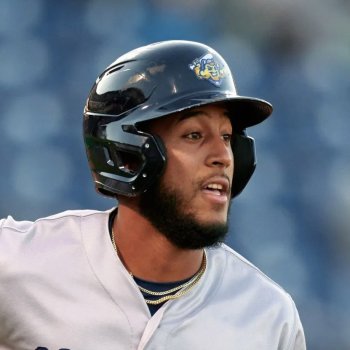Robo umps and the future of catchers
Twins Video
 In one of the discussion entries I saw the question - what will happen to catchers when the Robo ump is put in place and the quick hands ability to steal (frame) a strike is no longer a vital skill. This got me thinking about what are the other attributes of a good catcher.
In one of the discussion entries I saw the question - what will happen to catchers when the Robo ump is put in place and the quick hands ability to steal (frame) a strike is no longer a vital skill. This got me thinking about what are the other attributes of a good catcher.
My first thought is the ability to call a good game, to put the pitcher in a better position to fool the batter. Of course the Houston Astronauts are pushing for a change there too. Maybe we will have head phones on the catcher and pitcher and the pitching coach will become the defensive coordinator calling all the pitches. If so my criteria will change again. However, for now I will take the intellectual impact of the catcher and say that this was the most important and least appreciated of Joe Mauer's skills.
The ability of Joe and others to call a game is not easy to judge. For example; if you have Scherzer, Paxton, and Strasburg does their success make you a great game caller? Or if you have Nolasco, Hughes, and Milone are you a bad catcher? I guess we have to ask (world champion) Kurt Suzuki.
If you call for a pitch and the pitcher cannot deliver it as a quality offering it does not matter if it was the right pitch or not?
How do we decide on this skill? I do not know, but pitchers should have some idea - I wonder if that is why some pitchers have designated catchers who are not the regular catcher. Of maybe those catchers call what the pitcher wants rather than what should be called. I do not know how to decide.
So with the current conversations possibly eliminating those two qualities we get to the hockey goalie attributes - who lets the most baseballs get by for Wild Pitches and Passed balls? Here is a list of the most passed balls - https://www.foxsports.com/mlb/stats?season=2019&category=FIELDING+II&group=1&sort=7&time=0&pos=0&qual=1&sortOrder=0&splitType=0&page=1&statID=0
16 by Flowers in 83 games is atrocious - 226 innings - 0.07 pct . Grandal had 9 in 412 innings - 0.02. pct. Garver had 8 in 225 innings - 0.035 and Castro had 7 in 210 innings - 0.033. Former Twin minor leaguer John Hicks with Detroit had 3 in 244 innings 0.012. Former Twin Suzuki had 6 in 209 innings 0.0028. Former Twins minor leaguer Wilson Ramos had 10 in 338 - 0.029. According to Baseball Almanac Astudillo has zero passed balls in 37 games as catcher.
I could not find out who allowed the most Wild Pitches. But the Angels - 98, Boston 81, Baltimore 75, Seattle 75, and Oakland 74 - were the top five teams in Wild Pitches for the 2019 season. Minnesota was number 8 with 70. Those catchers were - Angels - LuCruy ,Boston -Vasquez, Baltimore - Severino, Seattle - Narvaez, Oakland - Phegley. Was it their fault or bad pitchers?
Then there are errors - I am not sure how everything is figured. I assume bad throws to the bags, but is a PB an error? (not according to MLB.com - A passed ball is not recorded as an error, but when a run scores as the result of a passed ball, it does not count as an earned run against a pitcher) and that makes no sense to me, so other errors would come from fielding bunts and taking throws on runners trying to score and catching the strikeout pitch (?). When I went to see the errors the first thing I saw was fielding pct and it made me laugh - these are 1000 fielding catchers in 2019 - Willians Astudillo, John Hicks, John Ryan Murphy, Drew Butera, When I look at the serious list of full time catchers the thing that stood out is Realmuto's 9 errors! How did he get them. I am still confused by catcher errors. Juan Castro had 1. Mitch Garver had 6 and Grandal 8!
The catcher's most striking attribute in the past was his arm, but in this day of no stolen bases that positive element seems like it has been removed by the current metrics. I hope it comes back strong - give me Ricky, Coleman, Wills, Brock, Aparicicio and the other speedsters! If we look at current stats Mitch Garver tops the league with a .162 caught stealing rate - followed by Wilson Ramos .153. Not much to look at because there were so few attempts.
Fangraphs WAR has Realmuto with 5.7, Grandal 5.2, Gaver 3.9, Vasquez 3.5. Tom Murphy 3.2. I hate to say it by I did not even know who Tom Murphy was. In case you do not know him either - he is a Seattle Mariner.
Garver gets his WAR points from offense. Fangraphs has points for Offense and Defense before calculating WAR. Realmuto, Hedges (Padres), Vazquez(Red Sox), Grandal, and Perez (Indians) rate the top five in Defense by fangraph measures. Mitch Garver is 22nd. and Castro is 17th. Suzuki is 33rd out of 37 catchers rated with 250 ABs minimum. Astudillo in 52nd out of 68 when I drop the ABs to 100. Garver is first by a wide margin when rating catchers with 250 ABs in offense with Contreras second and Grandal 3rd. Castro is 14. Astudillo is number 41 of 68 when I drop the ABs to 100 and look at offensive ratings.
So what is the future catcher's requirements:
- Stamina
- Quick reflexes
- Good arm
- Good bat
- Able to handle a runner coming in from third
Sounds like Garver will fit the future and I like Jeffers coming in to back him up.





7 Comments
Recommended Comments